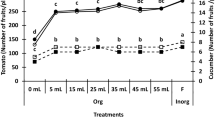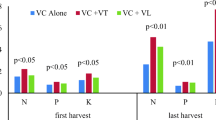Abstract
We examined the effects of fertilizer application, especially the effects of fertigation and types of fertilizer (inorganic and organic) on yields and δ15N and δ13C values of tomato (Lycopersicon esculentum Mill. cv. Saturn). Fertigation is a method in which an appropriate diluted liquid fertilizer is applied to the plants each time they are drip-irrigated. We developed a method of organic fertigation using corn steep liquor (CSL) as the liquid fertilizer, because it is an industrial byproduct of cornstarch manufacture and can be used very effectively. We compared fruit yield, mineral content, δ15N value, and δ13C value of tomatoes grown under three different fertilizer treatments, basal dressing: basal dressing with granular chemical fertilizer; inorganic fertigation: fertigation with liquid chemical fertilizer; and organic fertigation: fertigaion with CSL. Mineral contents of tomatoes grown with basal dressing were generally lower than those grown under either fertigation treatment. These results indicated that yields and mineral contents were influenced more by the method of fertilizer application than by whether the fertilizers were inorganic or organic. There were, however, significant differences in the δ15N values of tomato fruits grown under different types of fertilizer applications, especially between inorganic and organic fertilizers. The δ15N value of the chemical fertilizer used for basal dressing was 0.81 ± 0.45{‰}, that of the chemical fertilizer for fertigation was 0.00 ± 0.04{‰}, and that of CSL was 8.50 ± 0.71{‰}. The δ15N values of the soils reflected the δ15N values of the fertilizers. Moreover, the δ15N values of the fruits corresponded to the δ15N values of the applied fertilizers. The δ15N values were 3.18 ± 1.34{‰} in the fruits grown with a basal dressing of chemical fertilizer, 0.30 ± 0.61‰ in those grown under inorganic fertigation, and 7.09 ± 0.68‰ in those grown under organic fertigation. On the other hand, although the δ13C values in the soil also reflected the δ13C values of the applied fertilizers, there was no significant difference in the δ13C values of fruits among the different treatments. In conclusion, because the δ15N values of fertilizers correlated well with those of the fruits, it may be possible to use δ15N values as an indicator of organic products.
Similar content being viewed by others
References
Adams D 2001 Nutritionists question study of organic food. Nature 412, 666.
Balesdent J, Mariotti A and Boisgontir D 1990 Effect of tillage on soil organic carbon mineralization estimates from 13C abundance in maize fields. J. Soil Sci. 41, 587-596.
Hartz T K and Hochmuth G J 1996 Fertility management of dripirrigated vegetables. HortTech. 6, 168-172.
Hochmuth G J 1992 Fertilizer management for drip-irrigated vegetables in Florida. HortTech. 2, 27-32.
Inubushi K, Barahona M A and Yamakawa K 1999 Effects of salts and moisture content on N2O emission and nitrogen dynamics in yellow soil and andosol in model experiments. Biol. Fertil. Soils 29, 401-407.
Mariotti A, Germon J C, Hubert P, Kaiser P, Letolle R, Tardieux A and Tardieux P 1977 Experimental determination of nitrogen kinetic isotope fractionation: some principles; Illustration for the denitrification and nitrification processes. Plant Soil 62, 413-430.
Nakano A, Uehara Y and Yamauchi A 2001 Establishment of organic fertigation system using CSL (corn steep liquor) Effect of CSL on tomato (Lycopersicon esculentum Mill.) growth, yield, quality and soil chemical property. Jpn. J. Soil Sci. Plant Nutr. 72, 505-512.
Smith B L 1993 Organic foods vs. supermarket foods: element levels. J. Appl. Nutr. 45, 35-39.
Steele K W 1977 Fractionation of nitrogen isotopes by animals: a further complication to the use of variations in the natural abundance of δ15N for tracer studies. J. Agric. Sci. 90, 7-9.
Tokunaga T, Fukunaga A Matsumura T and Yoneyama 2000 Variation of natural 15N abundance (δ 15N ) in paddy rice supplied with chemical fertilizers and livestock manures, and estimation of soil-manure-and fertilizer-derived N by the isotope mass balance method. Jpn. J. Soil Sci. Plant Nutr. 71, 447-453.
Yamada Y, Morita A, and Yoneyama T 1999 Influence of different types of fertilizers on δ 15N values of crops, leached water (nitrate) and soils in lysimeters with three soils. Jpn. J. Soil Sci. Plant Nutr. 70, 533-541.
Yoneyama T and Sasakawa H 1994 Natural abundance of isotopes of carbon, nitrogen, oxygen, hydrogen and sulfur in soils and plants: research progress after 1987. Jpn. J. Soil Sci. Plant Nutr. 65,585-589.
Yoneyama T, Kouno K and Yazaki J 1990 Variations of natural 15N abundance of crops and soils in Japan with special reference to the effect of soil conditions and fertilizer application. Soil Sci. Plant Nutr. 36,667-675.
Yoneyama T 1996 Characterization of natural 15N abundance of soils. In Mass Spectrometry of Soils. Eds. T W Boutton and S Yamazaki. pp. 205-233. Marcel Dekker, New York.
Yoneyama T 2001 δ 15N values of sorghum grains harvested on a vertisol in the semi-arid tropics were positively related to doses of fertilizer N but negatively with the frequency of legume cultivation. Soil Sci. Plant Nutr. 47, 423-427.
Author information
Authors and Affiliations
Corresponding author
Rights and permissions
About this article
Cite this article
Nakano, A., Uehara, Y. & Yamauchi, A. Effect of organic and inorganic fertigation on yields, δ15N values, and δ13C values of tomato (Lycopersicon esculentum Mill. cv. Saturn). Plant and Soil 255, 343–349 (2003). https://doi.org/10.1023/A:1026180700963
Issue Date:
DOI: https://doi.org/10.1023/A:1026180700963




